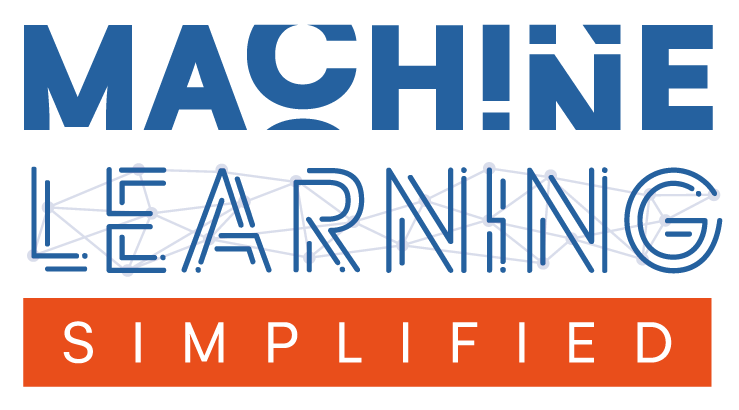Cross-validation Methods#
This is a supplement material for the Machine Learning Simplified book. It sheds light on Python implementations of the topics discussed while all detailed explanations can be found in the book.
I also assume you know Python syntax and how it works. If you don’t, I highly recommend you to take a break and get introduced to the language before going forward with my code.
This material can be downloaded as a Jupyter notebook (Download button in the upper-right corner ->
.ipynb) to reproduce the code and play around with it.
1. Required Libraries, Data & Variables#
Firstly, let’s generate the sample data for X and y.
import numpy as np
data = np.array([0.1, 0.2, 0.3, 0.4, 0.5, 0.6])
2. Cross Validation Methods#
The following methods are going to be shown:
2.1. Hold-out Cross Validation Method
2.2. K-Fold Cross Validation Method
2.3. Leave-One-Out Cross Validation Method
2.4. Leave-P-Out Cross Validation Method
2.1. Hold-out Cross Validation#
The hold-out method randomly splits the entire dataset into a training set and a test set. The training set is what we use to train the model,and the test set is what we use to see how well the model performs on unseen data.
Let’s split the dataset data. We do so by using a function train_test_split. The parameter test_size controls how many percentage of data we would like to allocate to the test set. If test_size=0.3, we allocate 30% of the dataset for a test set, and the remaining 70% for a training set.
from sklearn.model_selection import train_test_split
train, test = train_test_split(data, #specify the data to use
test_size=0.3) #specify the split ratio
Let’s see the results:
print('Train:', train, 'Test:', test)
Train: [0.6 0.2 0.1 0.4] Test: [0.3 0.5]
The hold-out method has randomly chosen 2 out of 5 observations for the test set (which makes roughly 30% of the entire dataset).
2.2. K-Fold Cross Validation (kFCV)#
kFCV is a resampling validation method where the dataset is split into \(k\) groups, called folds, and the algorithm is trained and evaluated \(k\) times, using each fold as a test set while the remaining folds works as a training set.
from sklearn.model_selection import KFold
kfcv = KFold(n_splits=3) #configure kFCV to have 3 folds
Let’s check the combinations of training and test sets:
for train, test in kfcv.split(data):
print('Train{}'.format(data[train]), 'Test{}'.format(data[test]))
Train[0.3 0.4 0.5 0.6] Test[0.1 0.2]
Train[0.1 0.2 0.5 0.6] Test[0.3 0.4]
Train[0.1 0.2 0.3 0.4] Test[0.5 0.6]
2.3. Leave-p-Out Cross Validation Method (LpOCV)#
LpOCV is a resampling validation method where the number of folds equals the number of observations in the data set. A parameter \(p\) is selected that represents the size of the test set. The learning algorithm is applied once for each combination of test and training sets, using selected \(p\) observations as the test set and the remaining observations as the training set.
from sklearn.model_selection import LeavePOut
lpocv = LeavePOut(p=2) #configure LpOCV to have p=2
Let’s check the combinations of training and test sets:
a=0
for train, validate in lpocv.split(data):
print("Train set:{}".format(data[train]), "Test set:{}".format(data[validate]))
a = a + 1
Train set:[0.3 0.4 0.5 0.6] Test set:[0.1 0.2]
Train set:[0.2 0.4 0.5 0.6] Test set:[0.1 0.3]
Train set:[0.2 0.3 0.5 0.6] Test set:[0.1 0.4]
Train set:[0.2 0.3 0.4 0.6] Test set:[0.1 0.5]
Train set:[0.2 0.3 0.4 0.5] Test set:[0.1 0.6]
Train set:[0.1 0.4 0.5 0.6] Test set:[0.2 0.3]
Train set:[0.1 0.3 0.5 0.6] Test set:[0.2 0.4]
Train set:[0.1 0.3 0.4 0.6] Test set:[0.2 0.5]
Train set:[0.1 0.3 0.4 0.5] Test set:[0.2 0.6]
Train set:[0.1 0.2 0.5 0.6] Test set:[0.3 0.4]
Train set:[0.1 0.2 0.4 0.6] Test set:[0.3 0.5]
Train set:[0.1 0.2 0.4 0.5] Test set:[0.3 0.6]
Train set:[0.1 0.2 0.3 0.6] Test set:[0.4 0.5]
Train set:[0.1 0.2 0.3 0.5] Test set:[0.4 0.6]
Train set:[0.1 0.2 0.3 0.4] Test set:[0.5 0.6]
2.4. Leave-One-Out Cross Validation Method (LOOCV)#
Leave-One-Out Cross Validation Method is a resampling validation method where the number of folds equals the number of observations in the data set. The learning algorithm is applied once for each observation, using all other observations as a training set and using the selected observation as a single-item test set.
from sklearn.model_selection import LeaveOneOut
loocv = LeaveOneOut() #configure LOOCV
Let’s check the combinations of training and test sets:
for train, test in loocv.split(data):
print('Train:', data[train], 'Test:', data[test])
Train: [0.2 0.3 0.4 0.5 0.6] Test: [0.1]
Train: [0.1 0.3 0.4 0.5 0.6] Test: [0.2]
Train: [0.1 0.2 0.4 0.5 0.6] Test: [0.3]
Train: [0.1 0.2 0.3 0.5 0.6] Test: [0.4]
Train: [0.1 0.2 0.3 0.4 0.6] Test: [0.5]
Train: [0.1 0.2 0.3 0.4 0.5] Test: [0.6]
NOTE: you can also use LPOCV, with p=1 - the result will be the same.
from sklearn.model_selection import LeavePOut
lpocv = LeavePOut(p=1) #configure LpOCV
#check the combinations of training and test sets:
a=0
for train, validate in lpocv.split(data):
print("Train set:{}".format(data[train]), "Test set:{}".format(data[validate]))
a = a + 1
Train set:[0.2 0.3 0.4 0.5 0.6] Test set:[0.1]
Train set:[0.1 0.3 0.4 0.5 0.6] Test set:[0.2]
Train set:[0.1 0.2 0.4 0.5 0.6] Test set:[0.3]
Train set:[0.1 0.2 0.3 0.5 0.6] Test set:[0.4]
Train set:[0.1 0.2 0.3 0.4 0.6] Test set:[0.5]
Train set:[0.1 0.2 0.3 0.4 0.5] Test set:[0.6]
